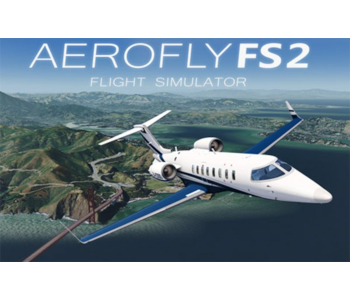5 Best VR Flight Simulators (Oculus, Vive, and PSVR)
Wearing a VR headset is one of the most immersive ways that you can enjoy a game or a movie. However, this unparalleled degree of immersion also makes VR technology a suitable fit for more practical applications. Flight sims have always been a staple of pilot training, but more and more institutions are recognizing the value of bringing flight sims into VR.
Whether you want to go through a flight sim for training or for pure recreation, doing it in VR is a whole new experience. In this article, we go through the best VR flight sims available today with great picks on each of the popular VR platforms.
What to consider when choosing a VR flight sim
1. Realism or entertainment?
While it’s possible for both realism and entertainment to co-exist in a single flight sim, one is often compromised in favor of another. Flight sims geared more towards realism, focus on making the interface look as similar as possible to the cockpit of an actual plane. The instrument panels give relevant data, and you need to react by pressing the right buttons. Modern flight sims have become so realistic that VR headsets have become mainstays of aviation and aerospace trade shows.
On the other hand, some VR flight sims are more focused on giving the player more exciting gameplay. These flight sims usually have simplified controls so that players can grasp them quickly. Action is the main focus of these flight sims. In many ways, action-oriented flight sims feel like playing an arcade game – quick, exciting, and easy to learn.
In either case, there’s one aspect where you would want your flight sim to pour some realism into – flight dynamics. How well your plane reacts to lift, drag, and other wind effects can make or break a flight sim.
2. What VR platform do you have?
If you want a satisfying flight sim experience, you need a VR headset that allows you to interact with the environment using handheld controllers. With this consideration, there really are only three platforms to choose from Oculus, HTC, and PSVR.
Both Oculus and HTC offer headsets that can either be used standalone or need to be tethered to a gaming PC. The PSVR, as the name implies, only works with a PlayStation 4 (standard, Slim, or Pro) console.
Chances are your choice of which flight sim to get will be heavily influenced by the VR headset platform you already have. If you don’t already have a VR headset, then head over to our buying guide for wireless VR headsets or the best VR headsets for PC.
The top 5 best VR flight sims
1. X-Plane 11

When it comes to flight sims, X-Plane has always been revered because of how realistic it is – sometimes to a fault. At a time when other flight sims focused on creating gorgeous environments, Laminar Research (the developers behind X-Plane) chose to stick to their strengths and focused on aircraft design and realistic user experience.
The X-Plane series has been around since the early 90s and actually came to the VR game a bit late. The 11th version of X-Plane has already been available for PC for a few years before being ported to VR. Despite the fact, Laminar was able to deliver a VR experience that is arguably still better than anything that came before it.
Interacting with anything in the VR cockpit is highly intuitive. Turning knobs feels smooth and responsive, the buttons are sensitive (albeit a bit too small), and checking the instrument readouts is so much easier with headset tracking, Controlling the plane using a virtual yoke instead of a physical joystick takes some getting used to, but it can be perfected. Since X-Plane 11 is played on a PC using the SteamVR platform, the option of hooking up a joystick controller isn’t entirely out of the question.
The biggest weakness of X-Plane 11 is that is simply doesn’t have the mass appeal that simpler flight apps have. It doesn’t have much action, and the user interface, both on the menus and the airplane cockpit, are a bit too complicated for gamers who aren’t exactly hardcore fans of flight sims. X-Plane 11 normally goes for $60 on Steam but can go as low as $20 if you can score it on a sale.
| Platform |
|---|
| Any SteamVR-compatible headset |
| PROS |
|---|
| Highly realistic |
| Excellent physics engine |
| CONS |
|---|
| Complex user interface |
| Expensive |
| Not user-friendly |
2. DCS World

First things first, Digital Combat Simulator (DCS) World can be downloaded and played for free. There is a lot of downloadable content, such as additional maps and aircraft, that you can pay for, but these are entirely optional. The fact that you can try out this flight sim without having to pay for anything is already worth a lot of points in our book.
The free version comes with two aircraft – a modern attack jet and a WWII-era trainer. The flight sim has been around for a while but only came out for VR at around 2015. Right now, the flight sim supports both Oculus Rift and HTC Vive headsets.
Entering a cockpit for the first time in DCS World sure is an overwhelming experience. VR has the unique characteristic of giving the user a sense of scale that is not possible with gaming on a monitor. This sense of scale is on full display in DCS World, especially since the flight sim allows you to exit the cockpit to walk around your aircraft.
The flight sim also does a fair bit of “hand-holding” so that beginners can make sense of the complex controls inside the cockpit. DCS World does a much better job than X-Plane 11 in this aspect, making this flight sim much more user-friendly.
The area where DCS World suffers is in resolution. Although the flight sim looks great on a typical PC monitor, looking at it up-close through a VR display only highlights how imperfect the graphics are. Fortunately, the cockpit looks detailed enough so you can see instrument readouts clearly, but the outside environment leaves a lot to be desired.
Overall, the drop in display resolution doesn’t completely ruin the immersion of DCS World, and we imagine that it’s a problem that can be solved with software upgrades or a headset with a better screen. Since the game is free to play, there’s really no reason for a flight sim fan not to try it out.
| Platform |
|---|
| Any SteamVR-compatible headset |
| PROS |
|---|
| Free to play |
| User-friendly |
| CONS |
|---|
| Expensive DLC |
| Poor graphics resolution |
3. Aerofly FS2

Another flight sim that straddles somewhere between entertaining and realistic is Aerofly SF2. This flight sim has actually been quite popular, even before it was ported to VR. It’s quite cheap – you can get it for around $20 or less on Steam. The base game comes with twenty aircraft, a nice selection of maps, and a virtual Interactive Flight School. For the price you need to pay for the base game, AeroFly SF2 presents a compelling purchase if you’re looking to maximize value.
The experience of being in the cockpit, turning dials, and flipping switches are very good. There’s haptic feedback whenever you press a button or flip a switch, which is quite satisfying. Shifting a lever or turning a yoke is less precise due to the lack of physical resistance, but this is a limitation of VR controls that is yet to be overcome.
There is a bit of simplification in how the controls of the Aerofly SF2 were designed to make it more accessible to casual gamers. The downside is that this flight sim might not appeal to those who are looking for the most realistic experience. There’s no ATC to get in touch with or AI-controlled flights in single-player mode, and the game does not offer a multiplayer mode.
Another area where Aerofly SF2 has been heavily criticized is the lack of a dynamic environment. Outside of the cockpit, everything in this flight sim feels flat. There is no changing weather, there aren’t many detailed buildings, and you don’t see any other aircraft. Overall, the world of Aerofly just seems lifeless.
The lack of textured landscapes can be somehow addressed if you download any of the texture packs for the flight sim, although this would set you back a few additional bucks.
| Platform |
|---|
| Any SteamVR-compatible headset |
| PROS |
|---|
| User-friendly |
| Good haptic feedback on controls |
| Cheap |
| CONS |
|---|
| Low-resolution graphics |
| Non-dynamic environment |
| Expensive DLC |
4. Ace Combat 7

Ace Combat 7 is one of the most breathtaking games to come to the PSVR, PlayStation’s very own VR platform. The PSVR has nowhere near the number of games that you can play using the SteamVR platform, but it’s essentially just an add-on to what is arguably the most successful gaming console of this generation.
The flight sim was released only earlier this year and takes advantage of with better graphics and an experience that was specifically crafted for the PSVR handheld controllers. If you want a controller with better tactile feedback, you also have the option of hooking up a third-party flight stick to the PlayStation 4.
Out of all the flight sims in this list, Ace Combat 7 is by far the most action-oriented. If you’re looking for exciting and fast-paced aerial combat, then this is the perfect title for you. The game was made to appeal to all types of gamers, so the controls and mechanics are all quite basic. As you would expect, it’s not exactly the most realistic.
We have a major gripe when it comes to reviewing Ace Combat 7 as a VR flight sim: the VR campaign only lasts three missions. The fact that the VR missions were so well executed makes it harder to accept the fact that the rest of the flight sim has to be played using a standard controller and on your TV. Multiplayer mode also doesn’t support VR, which is a shame because that would have been a wonderful experience.
Fortunately, Playstation games can get very cheap several months after release. There’s a good chance that you can get a copy of Ace Combat 7 for less than $20 nowadays. While it’s not exactly a realistic flight sim, any fan of aviation-related games is sure to get a kick out of this one.
| Platform |
|---|
| PSVR |
| PROS |
|---|
| Excellent graphics |
| Easy to learn controls |
| CONS |
|---|
| Less focused on realism |
| Short VR content |
5. Ultrawings

One look at Ultrawings, and you’ll know that the developers did not strive at all for realism. The graphics, including the cockpit and the environment, as stylishly cartoony. This isn’t necessarily a bad thing, and it accurately reflects that this is a light-hearted and fun flight sim. However, more hardcore flight sim fans will almost certainly not be interested in this game.
Ultrawings is somewhere between an arcade flier and a flight sim, although we have to say that it’s slightly leaning towards a more arcade-like style. Instead of having to pay for additional aircraft, you have to earn them in-game by doing a series of challenges. Most of these challenges have you flying through rings, shooting targets with a handheld gun, or successfully landing your plane at a designated spot.
This flight sim is great for winding down at the end of the day. None of the mechanics are complex, and flying around the colorful world is very relaxing. With its open-world mechanics, you’re free to fly around the various islands and discover new airports, each one with a series of new challenges waiting for you to unlock. There’s no pressure here – you can do everything at your own pace.
Ultrawings is available through both SteamVR and PSV4, making it a rare flight sim that can be played using practically any of the high-profile VR headsets in the market today. This flight sim offers a fun, laid-back experience for everyone, whether you are an accomplished pilot or someone who’s never played a flight sim before.
| Platform |
|---|
| Any SteamVR-compatible headset; PSVR |
| PROS |
|---|
| User-friendly |
| Stylish graphics |
| Extensive headset compatibility |
| CONS |
|---|
| Lacks realism |
| Limited content |
Final thoughts
A flight sim seems like one of the best ways to flex the possibilities of VR technology. Playing a flight sim in VR just gives you a sense of scale and immersion that is not possible with old-fashioned gaming with a TV or monitor. This isn’t a new concept, either, as many flight schools have already recognized how VR-aided flight sims can be a legitimate training tool.
The selection of flight sims that are compatible with VR headsets is admittedly still very limited. Aside from the five we’ve listed here (which are some of the best), there aren’t a lot of other options out there. VR gaming is still on the rise, though, and we don’t expect developers to forget about flight sims anytime soon.


You missed the best and funnest vr flight game available today. Aces High III from hightechcreations.com is just awesome and has the best touch controller support bar none.
VTOL VR is one of the best I’ve played, realism with a touch of fun, and the environment is designed around the game, rather than vice versa (or worse, real life), and being a more military focused one it’s a lot of fun toying around with the weapons. There’s story missions, and a ton of content.
You missed the best soaring simulator Condor 2.